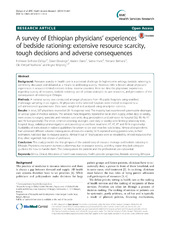| dc.description.abstract | Background Resource scarcity in health care is a universal challenge. In high-income settings, bedside rationing is commonly discussed and debated as a means to addressing scarcity. However, little is known about physicians’ experiences in resource-limited contexts in low- income countries. Here we describe physicians’ experiences regarding scarcity of resources, bedside rationing, use of various strategies to save resources, and perceptions of the consequences of rationing in Ethiopia. Methods A national survey was conducted amongst physicians from 49 public hospitals using stratified, multi-stage sampling in six regions. All physicians in the selected hospitals were invited to respond to a self-administered questionnaire. Data were weighted and analyzed using descriptive statistics. Results In total, 587 physicians responded (91 % response rate). The majority had experienced system-wide shortages of various types of medical services. The services most frequently reported to be in short supply, either daily or weekly, were access to surgery, specialist and intensive care units, drug prescriptions and admission to hospital (52, 49, 46, 47 and 46 % respectively). The most common rationing strategies used daily or weekly were limiting laboratory tests, hospital drugs, radiological investigations and providing second best treatment (47, 47, 47 and 39 % respectively). Availability of institutional or national guidelines for whom to see and treat first was lacking. Almost all respondents had witnessed different adverse consequences of resource scarcity; 54 % reported seeing patients who, in their estimation, had died due to resource scarcity. Almost 9 out of 10 physicians were so troubled by limited resources that they often regretted their choice of profession. Conclusion This study provides the first glimpses of the untold story of resource shortage and bedside rationing in Ethiopia. Physicians encounter numerous dilemmas due to resource scarcity, and they report they lack adequate guidance for how to handle them. The consequences for patients and the professionals are substantial. | en_US |


